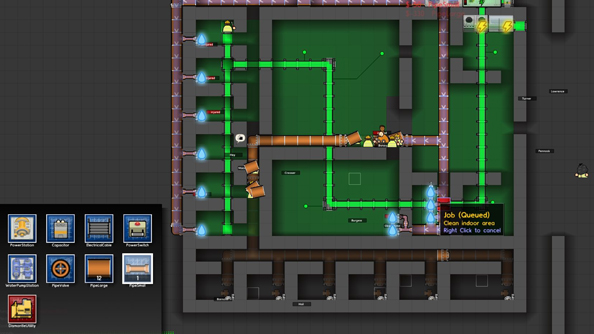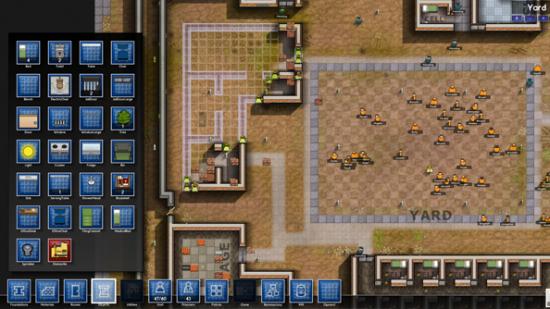Prison Architect has broken free onto Early Access; here’s our Prison Architect review.
My first prison ran out of money before I bought any guards, leaving my first prisoners milling about in the parking lot shackled and alone. Second try ended when I forgot to build any walls and five of them ran away before I locked all the doors. The third attempt was a little more successful until my cooks couldn’t cook bacon fast enough and a riot broke out in the canteen, ending with three prisoners dead and a pair of guards spluttering their last over some overcooked eggs. I’ve come to realise I should never be put in charge of anyone, let alone an entire prison of violent angry inmates. Prison Architect is now in alpha, and I’m terrible at it.
“There’s a principle called Maslow’s Hierarchy of Needs” Chris Delay, Director of Introversion and Lead Programmer on Prison Architect, tells me. “It’s a psychological principle that everyone has a pyramid of needs. At the base is unavoidable requirements like food and sleep and then you go up to safety and comfort.” The first order of business in Prison Architect? Slap down some beds and get a kitchen up and running. If you can’t keep your prisoners from starving and collapsing from exhaustion, you’re not going to get very far. “Higher than that you get some social requirements like friendship before right at the top you have high level objectives like betterment, improving yourself, things like that.”
The way that these needs thread themselves through Prison Architect is fascinating to watch, especially when you’ve only got the most basic understanding of what’s wrong, and why half your inmates are beating the other half into a barely-alive pulp. “With our prisoners, they arrive with a grab bag of needs. At any one time they’ll try to satisfy the needs at the top of their list. So if you’ve got a classroom and your prisoners are all trying to avoid being stabbed and not being fed properly, they’re not going to get anything out of the classroom.” So you’ve got to prioritise, building and staffing the facilities that are most pertinent, rather than just what’s the most interesting.
When you start Prison Architect, you’ve got a handful of workers and a wide open space, with 24 hours to prepare before the first inmates arrive. This is sandbox mode, where you’re given complete control over your prison, and it’s just about getting it to run properly. It’s a pretty tight timer, if you want to do things right, and if your convicts arrive and you’ve only just finished the holding pen, they’re going to start getting lairy pretty quickly.

And that, in brief, is the experience of playing Prison Architect. You’re putting out fires constantly, trying to cater to the most basic of needs while the more haughty objectives of betterment and rehabilitation fall by the wayside. Everything costs money, and while it would be lovely to build a massive expansive wing to house everyone in spacious cells, it’s far cheaper, and far more efficient, to meet the minimum requirement of a 2×3 box with a bed and a toilet in. After all, you’re going to have to spend time putting in the plumbing and electricity, so really it’s the least they could do to be grateful, the violent buggers.
The only problem is you’re then mixing together complicated systems and, well… “I set up some cameras in the showers because there are never any guards in there.” Chris continues. “We have a sort of fog of war and if you can’t see somewhere it’ll be hidden in darkness. So I put in the cameras and it electrocuted everyone in the shower when they came in. It’s because there’s an electricity system, and whenever they get wet they short and zap everyone. And the water interacts with it. So when I turned them on it created a live electrical bed on the floor and everyone in the room was electrocuted.”
Bugs like this are rife in the game, and will be for some time, as this is a very early build. But regardless of how much they interfere with the tone and simulation of the game, there’s something a little bit funny about it. Testament to that, Introversion’s twitter account has been posting the best of these, with inmates eating lunch in the middle of a blaze, or being sent to solitary for carrying a very dangerous fork while eating lunch. It’s demonstrating quite how complex the mechanics are that churn beneath the surface of the game, each one a complicated system in its own right, but when mixed together create something emergent and fascinating.
“I’m a huge Dwarf Fortress fan.” Chris tells me. “It was my third major attempt at Dwarf Fortress that I was actually successful, and actually ran a fortress that sustained itself. We don’t want to bring across that inaccessibility, but I do love that level of detail that is found in Dwarf Fortress. I think it’s one very interesting avenue of development, just to keep adding to systems and simulations to the extent that your world is so elaborate that amazing things just happen.” While Introversion don’t have machinations on creating an entire world of such systems, there’s plenty of issues concerning prisons that they shouldn’t be starved of inspiration.

“You’re effectively managing a closed society of prisoners and guards that has its own peculiar set of rules. And you’re trying to keep it running smoothly in all the different ways. Are you actually making a difference, are you helping anyone, improving anyone, or is it the other way around? Are you punishing people, and making them remorseful.” The idea is to create an end game where you’ve stopped spluttering and dashing from problem to problem, and are actually able to make some decisions about the politics of your prison. The example you want to set.
“Our intention from the beginning was to cater to both extremes.” Chris continues. “Completely right wing locked down mega jail with really, really extreme security versus an extremely left wing, all about prisoner rehabilitation, facility, and everything in between. We certainly don’t want to frame any side of that argument as the right way.”
And with its contrast of cute cartoons for the majority of the game, and a more involved, sombre tone of polaroid illustrations for specific story instances, it has all of the comedy inherent in the concept of giving untrained players control of a large prison facility, but still manages to maintain the mood that these are people that have done bad things, and they’re here so that they can’t continue doing them.
As for the alpha itself, it’s still fairly bare bones, with not much more than the bare essentials you need to run a prison, with medical and psychiatric facilities about as advanced as things get. But the systems are all in place, and there’s plenty to tinker with; prisoners have their hierarchy of needs, and you’ve got more than enough tools to help or hinder them in their satisfaction. What’s there is fascinating enough, and you can all but see where it’s going to go, how it’s going to become more and more complex and intricate, and I frankly can’t wait to see how much more grossly incompetent I can become at basic care of a large group of people.
